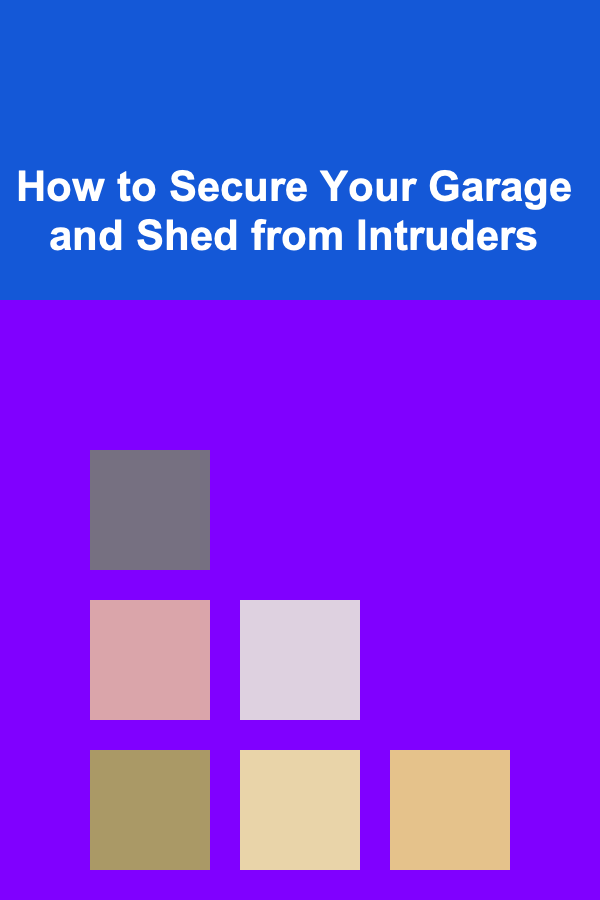
How to Etch Glass Bottles for Home Decor
ebook include PDF & Audio bundle (Micro Guide)
$12.99$9.99
Limited Time Offer! Order within the next:
Not available at this time

Etching glass bottles is a creative and rewarding craft that allows you to turn everyday glass items into beautiful, customized decor pieces. Whether you're looking to create elegant vases, unique lighting fixtures, or decorative centerpieces, etching can add a personalized touch to any room in your home. In this guide, we'll explore the process of etching glass bottles for home decor, providing step-by-step instructions, tips, and inspiration to help you get started.
What You Need to Know About Glass Etching
Glass etching is the process of creating designs or patterns on the surface of glass by using an abrasive or acid. The etching process creates a frosted, matte finish that looks elegant and unique. While it's often used on windows, mirrors, and glassware, etching glass bottles for home decor can give your space a distinctive, personalized style.
There are two primary methods for etching glass: the chemical method, which uses acid, and the abrasive method, which uses sandblasting or etching cream. For home decor projects, etching cream is the most commonly used technique because it's safe, affordable, and easy to use for beginners.
Step-by-Step Guide to Etching Glass Bottles
1. Choose the Right Glass Bottles
The first step in any glass etching project is selecting the right bottles. While glass bottles of all shapes and sizes can be etched, it's important to consider the purpose of your decor item and the design you want to achieve. For example:
- Wine or liquor bottles: These make great vases, candle holders, or decorative items.
- Soda or juice bottles: These are typically smaller and ideal for creating smaller decorative pieces, such as jar lanterns or flower holders.
- Mason jars: Known for their rustic aesthetic, mason jars can be transformed into elegant, etched centerpieces or storage containers.
Clear or lightly tinted bottles work best for etching because the contrast between the frosted design and the transparent glass will be more noticeable. However, colored glass can also be etched for a more subtle look, depending on your preferences.
2. Prepare Your Work Area
Before you begin etching, make sure you have a clean and well-ventilated workspace. Etching glass involves chemicals or abrasives, so it's important to have adequate ventilation and take safety precautions. Here's what you'll need to do:
- Protect your work surface: Lay down newspaper, a plastic tablecloth, or a disposable cloth to protect your workspace from spills.
- Gather your tools and materials: You'll need etching cream (such as Armour Etch or another brand), rubber gloves, a stencil or adhesive vinyl, a brush or sponge, painter's tape, a plastic scraper, and a protective mask or safety glasses.
- Wear protective gear: Etching cream contains acid, so it's important to wear rubber gloves, protective eyewear, and a mask to avoid skin or eye contact.
3. Clean the Bottles Thoroughly
The glass bottles must be completely clean before you begin etching. Any dirt, oil, or residue on the surface can interfere with the etching process, so cleaning is an essential step.
- Wash the bottles with warm soapy water to remove any dirt or labels.
- Use a razor blade or utility knife to carefully remove any labels from the bottles. If there's adhesive residue left behind, apply rubbing alcohol to remove it.
- Dry the bottles with a soft cloth or paper towels to ensure they're completely dry before etching.
4. Design Your Etching Pattern
Once your bottles are clean and dry, the next step is to decide on the design you want to etch. There are a variety of design options depending on your skill level and the aesthetic you're going for.
- Freehand Design: If you're confident in your artistic abilities, you can etch a design freehand. This is a more advanced technique that requires a steady hand and precision.
- Stencil Design: For a more controlled design, you can use a stencil or adhesive vinyl cutouts. This method is popular for beginners because it ensures clean, defined lines. You can either purchase pre-made stencils or create your own custom designs using adhesive vinyl sheets and a cutting machine like Cricut.
- Decals or Masking Tape: Another option is to use masking tape or decals to create a pattern. Simply tape the areas of the bottle you want to remain untouched, leaving the spaces you want to etch exposed.
It's important to note that the design should be firmly secured to the bottle to prevent movement during the etching process. Use painter's tape to secure any edges of the stencil or vinyl, ensuring there are no gaps where the etching cream could seep through.
5. Apply the Etching Cream
With the stencil or design in place, the next step is to apply the etching cream. This is the key step that will create the frosted effect on the glass.
- Apply the cream: Using a paintbrush or sponge, apply a generous amount of etching cream to the exposed areas of the bottle. Make sure the cream completely covers the areas you want to etch.
- Leave the cream on: Let the cream sit on the glass for about 5 to 15 minutes. The exact time will depend on the brand of etching cream you're using, so always refer to the instructions on the packaging. The longer the cream sits, the more pronounced the etching effect will be.
- Monitor the process: Don't leave the cream on for too long, as it can create a rougher finish or damage the glass if left to sit for an extended period.
6. Rinse Off the Etching Cream
Once the cream has had time to work its magic, it's time to rinse it off.
- Rinse thoroughly: After the recommended time, carefully rinse the bottle under warm water. Make sure to remove all traces of the etching cream.
- Peel off the stencil or vinyl: Once the cream is rinsed off, peel away the stencil or vinyl from the bottle. Take your time to ensure you don't accidentally damage the etched design.
- Dry the bottle: Dry the etched bottle with a soft towel, and inspect your design. You should see a frosted, matte pattern or image where the cream was applied.
7. Finishing Touches
At this point, your etched glass bottle is likely ready for display. However, you can take a few additional steps to enhance its appearance or add extra protection.
- Polishing: If you want to smooth out the etched surface or give it a glossy finish, you can use a glass polishing compound. Apply the compound with a soft cloth in small circular motions, being careful not to damage the etching.
- Decorative Additions: You can further personalize the bottle by adding decorative elements such as twine, ribbon, or painted designs. For example, wrapping the neck of a bottle in twine or adding LED lights inside can turn it into a charming home accent.
8. Caring for Your Etched Glass Bottles
Etched glass requires special care to maintain its beautiful appearance. While the design is permanent, the frosted effect can fade over time if the bottle isn't properly maintained. Here are some tips for keeping your etched bottles looking their best:
- Gentle cleaning: When cleaning etched glass bottles, avoid abrasive sponges or harsh chemicals. Instead, use a soft cloth and mild soap or a glass cleaner.
- Avoid scratching: Be mindful of any sharp objects that could scratch or damage the etched surface. Although the etching is permanent, it can become less visible if the surface is scratched.
Creative Ideas for Etched Glass Bottle Decor
Etched glass bottles can be transformed into a variety of home decor items. Here are some creative ideas to inspire your next project:
- Etched Wine Bottle Vases: Turn empty wine bottles into elegant vases by etching floral patterns or geometric shapes onto the glass. These make beautiful centerpieces for dinner tables or mantlepieces.
- Glass Bottle Lanterns: For a rustic or vintage look, turn glass bottles into lanterns by adding a candle inside. Etching the bottle with intricate designs will allow the candlelight to shine through, creating a warm, inviting ambiance.
- Etched Bottles as Storage Containers: If you're looking for functional decor, you can etch glass bottles to use as storage containers. Etched bottles can hold anything from dried flowers to cotton balls or even kitchen essentials like sugar or flour.
- Personalized Gifts: Etched glass bottles make for thoughtful, personalized gifts. Add a special message or design to a bottle to commemorate an event such as a wedding, anniversary, or birthday.
- Bottle Chandeliers: For a dramatic effect, group several etched bottles together and hang them to create a unique chandelier or pendant light.
Conclusion
Etching glass bottles for home decor is a fun, affordable, and creative way to personalize your living space. By following the steps outlined in this guide, you can transform ordinary glass bottles into stunning pieces of art that add charm, elegance, and individuality to any room. Whether you're a beginner or an experienced crafter, glass etching offers endless possibilities for creating unique and memorable home decor items. So gather your supplies, let your creativity flow, and enjoy the process of etching beautiful designs into glass.

How to Maintain Your Rental Property on a Budget
Read More
How to Secure Your Garage and Shed from Intruders
Read More
How to Use DIY Wall Murals for Budget-Friendly Home Art
Read More
Why Creating a Cozy Nook Can Improve Wellbeing
Read More
How to Master Xeriscaping for Drought-Tolerant Gardens
Read More
10 Tips for Financing a Luxury Vehicle: Options & Strategies
Read MoreOther Products

How to Maintain Your Rental Property on a Budget
Read More
How to Secure Your Garage and Shed from Intruders
Read More
How to Use DIY Wall Murals for Budget-Friendly Home Art
Read More
Why Creating a Cozy Nook Can Improve Wellbeing
Read More
How to Master Xeriscaping for Drought-Tolerant Gardens
Read More